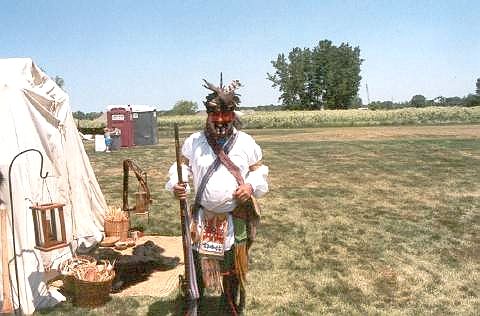
Feast of The Strawberry Moon, Encampment
Imagine...
It is early Summer, the month of the "Strawberry Moon," in the year 1752. You are a fur trapper. All this past Winter and Spring you have been setting your traps and hunting along the banks of the Grand River. The Grand River is the longest river in the lower peninsula of what would later be called, Michigan.
Now you need to trade your harvest of Beaver, Lynx, Martin, Deer, Wolf, Squirrel & Rabbit skins for fresh supplies of Tea, Beans, Corn, Tobacco, Gun powder, Lead (for shot), Flour, Rum, Trade Goods and equipment that you've lost and worn out, or broken. So, when the time is right, you load up your canoe and paddle down the Grand River to a point near where it empties into Lake Michigan.

Man in Pottawattamie Indian Dress
The Pottawattamie Indians, (who lived in this area when the Europeans arrived), called this spot, Gabagouache, which translates into English as, "big mouth," for the river mouth at the lake.
About 247 miles North (along the Lake Michigan shoreline), in the Straits of Mackinac, which is the narrow body of water which separates the Upper & Lower Peninsulas of Michigan and joins Lake Michigan (to the West) with Lake Huron (to the East) sits Mackinac Island. [Forget how it's spelled, it's pronounced Mackinaw]. Because this island commands water travel between these two Great Lakes, the French, who were the first Europeans to arrive in the area, built a fort on it and established a trading post in the fort for trading with the Indians. Later, the British took over the area, and the fort, from the French and used it for the same purpose.
Boats and canoes came South from the main fur trading post at Ft. Mackinac with all the items that you, and Indians who were in the fur trade, might want or need. They stopped where the various rivers emptied into Lake Michigan and set up temporary encampments where the trading of furs took place. These encampments usually had a detachment of military troops attached, for protection from River Pirates or Indian Attack. They also kept track of the value of the trading for tax purposes, and they kept order, hearing complaints, making arrests, holding court, etc.
And so it is that you take your furs down the Grand River in your canoe to Gabagouache, and an island in the river about 1 1/2 miles upstream from Lake Michigan, (and behind some high sand dunes which offer considerable protection from storms coming across the lake from the West). The traders from Mackinac Island have already set up camp with their military escort and await your business.
Let's take a look at that encampment, OK?
 This is a
row of tents which faces another similar row (that you can't see) off the left
side of the picture. The open space between the two rows formed a kind of
Company Street, where community activities took place, and fires were kindled
for cooking and warmth.
This is a
row of tents which faces another similar row (that you can't see) off the left
side of the picture. The open space between the two rows formed a kind of
Company Street, where community activities took place, and fires were kindled
for cooking and warmth.
You see women, which was not unusual for this period. Women accompanied their men whether civilian or military when they moved.
Let's look inside a few of the tents.
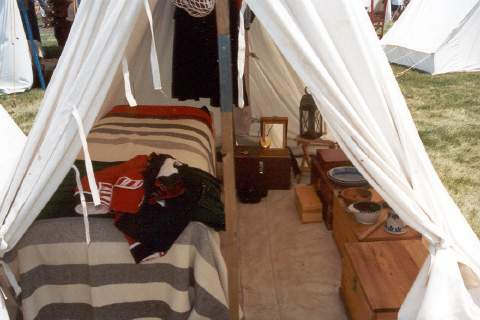
This tent would have belonged to a British Army Officer. His dress coat is on the bed which is covered with a thick wool Hudson Bay blanket. (I wish I could afford to buy one of these blankets, today). As an officer, he doesn't have to carry his own gear, so you see several trunks, basins, bowls, a lantern and a mirror. The floor of the tent is covered with woven rush mats. This man is quite comfortable in the "Wilderness." His bed is on a cot, not on the ground.
This picture shows the right half of a two-man tent
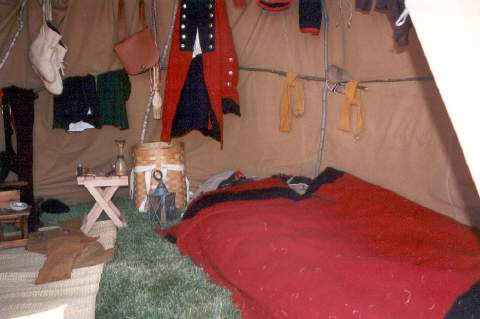
These tents were used by enlisted men and non-commissioned officers. Not too many creature comforts. The beds are on the ground, grass, straw or pine boughs wrapped in canvas for a mattress. In this case they also had a woven rush mat to cover part of the floor with. Clothing, pouch, deer skin boots, are hanging up and a woven back-pack along side of a small folding table, sit on the ground.
 Of course, people have to eat! This Lady was making Fried Pan Bread. Flat
squares of biscuit dough, dropped into that kettle of hot fat until the dough
gets golden and floats to the top. The bread is scooped out of the fat and
allowed to drain. Maple sugar is sprinkled over the bread pieces.
Mmmm Good! Other cooking fires had roasts and turkeys turning on hand
cranked squewers over beds of hot coals. The sights and sounds made your
mouth water.
Of course, people have to eat! This Lady was making Fried Pan Bread. Flat
squares of biscuit dough, dropped into that kettle of hot fat until the dough
gets golden and floats to the top. The bread is scooped out of the fat and
allowed to drain. Maple sugar is sprinkled over the bread pieces.
Mmmm Good! Other cooking fires had roasts and turkeys turning on hand
cranked squewers over beds of hot coals. The sights and sounds made your
mouth water.
A lot of the things we saw the people using were not made in factories, but hand-made by craftsmen. Many of the guns, the pots & kettles, the iron-work like the cranes and grates over the cooking fires and knives and hatchets were made by blacksmiths. I didn't get his picture, but there was a blacksmith plying his trade at the encampment. Wooden items were made by carpenters and wheelwrights.
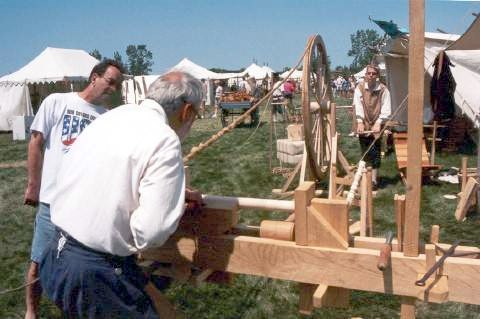 This
picture shows a man turning a spindle on a wood lathe.
This
picture shows a man turning a spindle on a wood lathe.
The apprentice in the background is turning a crank attached to a large wheel which is hooked to the lathe by a rope. A moderate cranking speed will make the lathe and the spindle spin quite fast. I found the ingenuity of some of the things these people were doing to be fascinating.
Many of you have witnessed cannons being fired. They look like this:
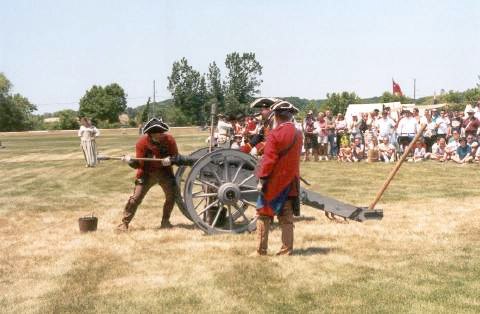
First they load the the cannon, and then
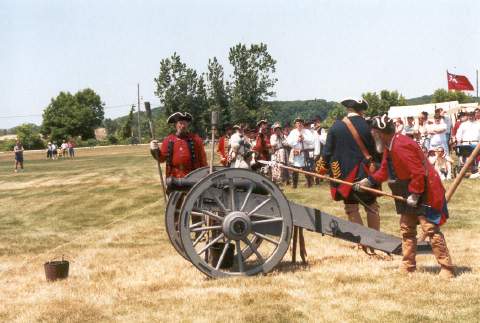
The man on the far right touches the powder in the touch-hole with the slow-match on a pole.
BOOM! This is usually what you see next, lots of smoke.
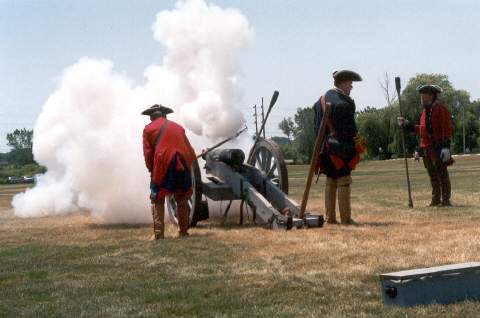
And that's what I saw too, on each of the first 2 of three shots. But on the third and last firing, I got this next (and last) picture.

This discharge of fire from the muzzle and the touch-hole happens so fast that your eye barely sees it, and most times, you don't see it. This is perhaps the most amazing picture I've ever taken and I wanted to share it. So I told this whole story, just to showcase this picture. Can you believe that?
Well, I wanted to tell you about our amazing day and encourage you all to go to an reenactment if you get the chance. If you do, take your time and talk to the re-enactors. Most of them really know their stuff, and they will want to tell what they know. I promise you a wonderful learning experience.
Oh yes, if you want to take a picture like this one, you'll need to use very high-speed film in a camera capable of shutter speeds in excess of 1 : 1,000th of a second. I was using 800 ASA Kodak film.